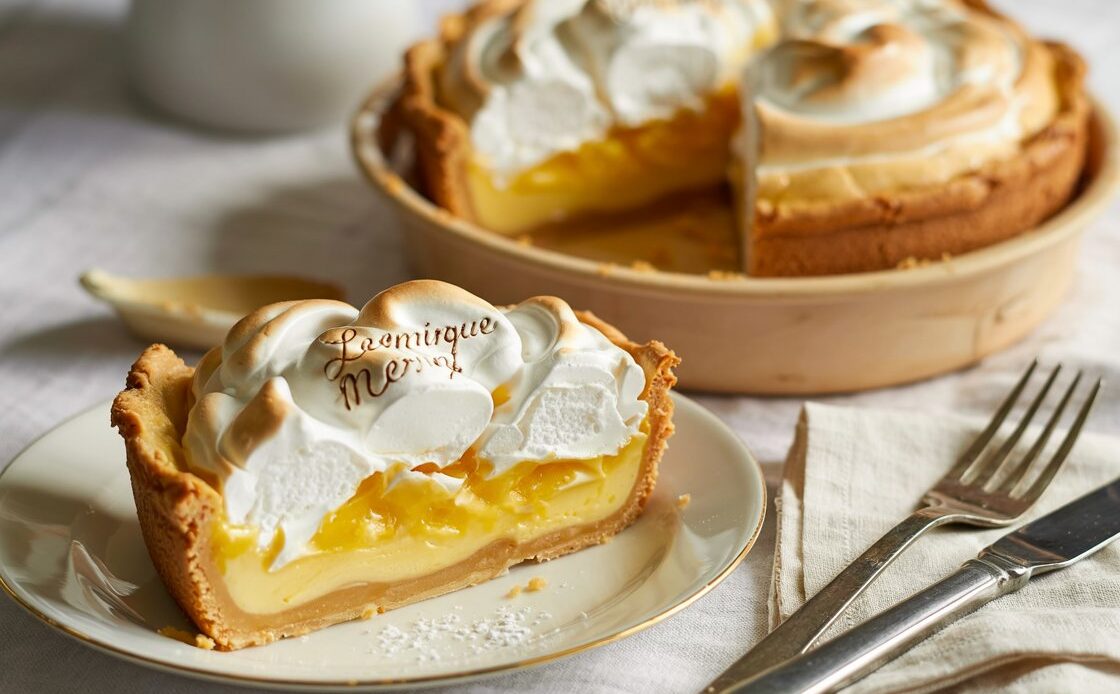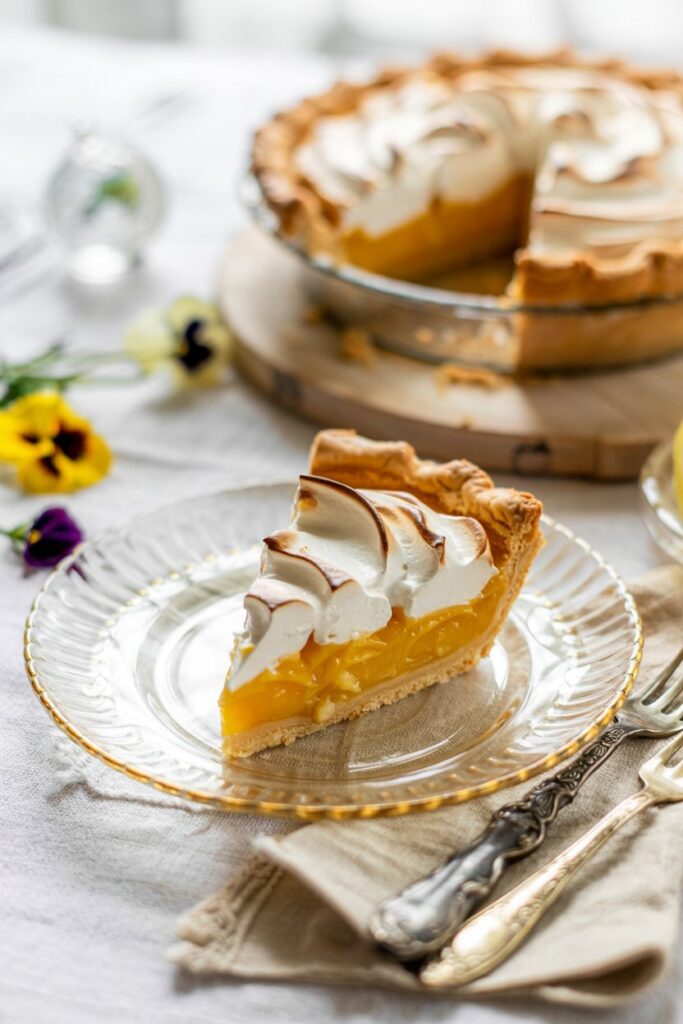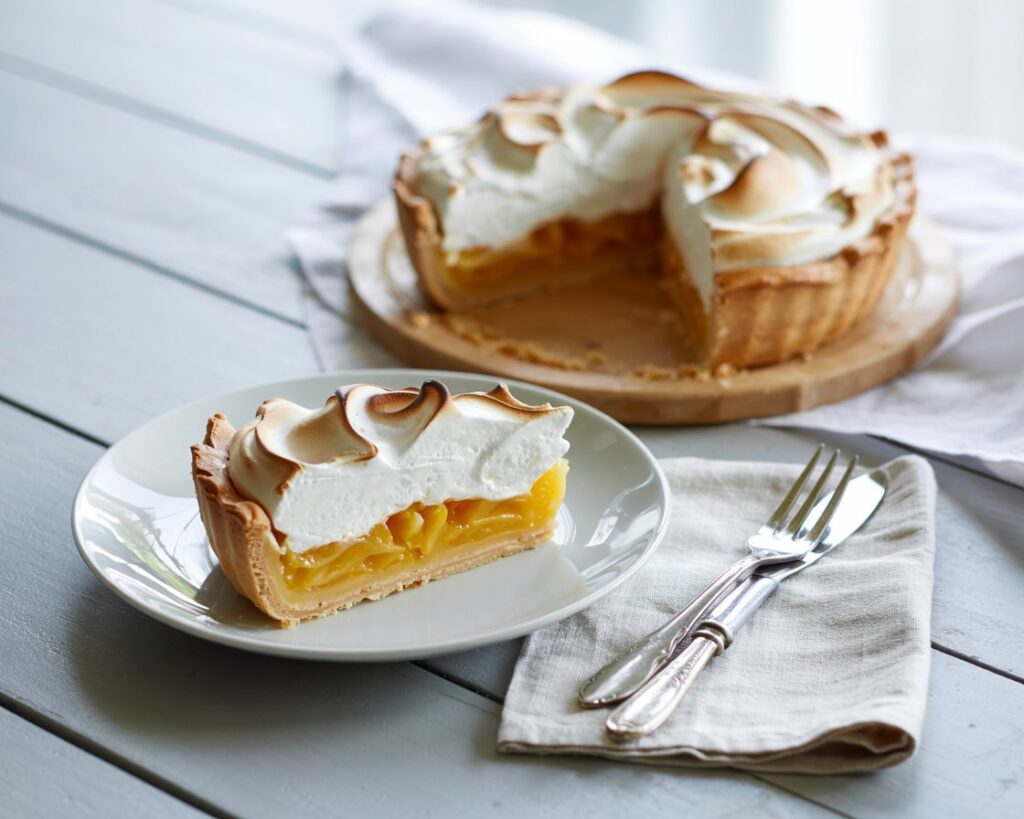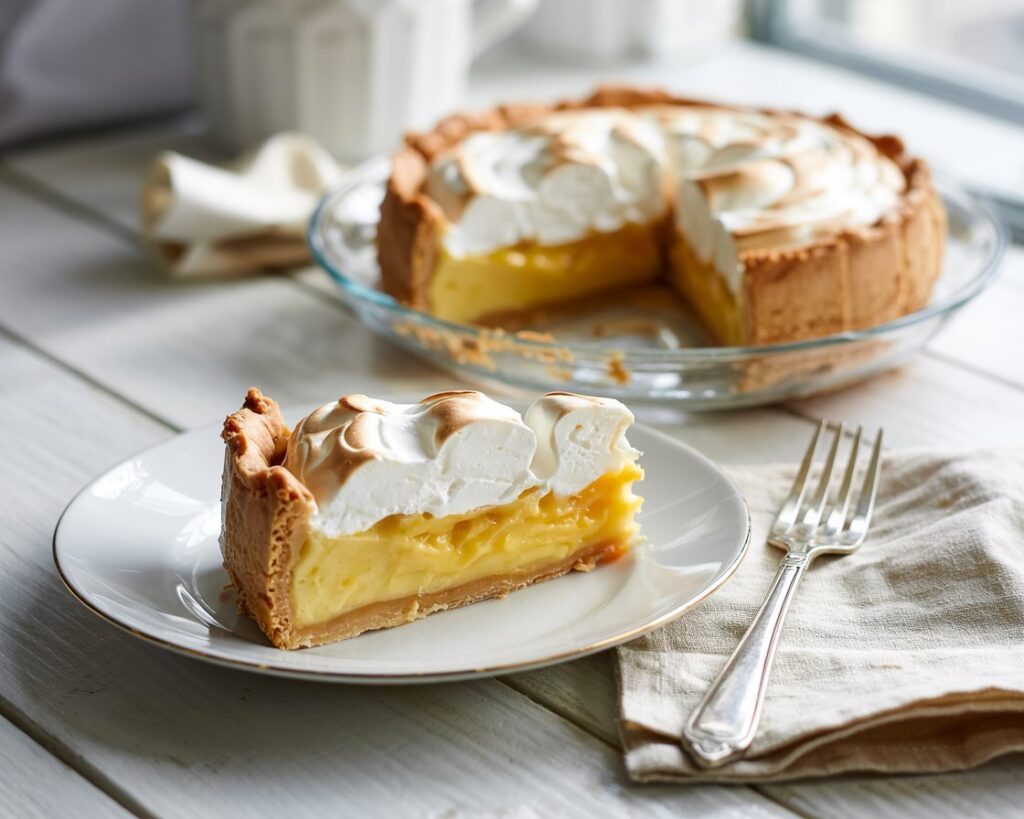
Lemon Meringue Pie isn’t just a dessert—it’s a showstopper. With its buttery crust, tangy lemon curd, and cloud-like meringue peaks, this pie balances bold flavor with delicate texture in every bite. But here’s the twist: not all lemon meringue pies are created equal. In this post, we’re going beyond the usual to explore what actually makes a lemon meringue pie unforgettable—from common baking mistakes to flavor science and creative variations you’ll want to try immediately. Ready to make the best one you’ve ever had? Let’s dive in.
Why Lemon Meringue Pie is a Classic That Never Goes Out of Style

Lemon meringue pie has stood the test of time, becoming a beloved dessert in households around the world. With its balance of tart citrus filling, sweet meringue topping, and buttery crust, it strikes a perfect harmony of flavors and textures. Whether served at family gatherings, dinner parties, or as a special treat, this dessert offers something truly timeless. In this section, we’ll explore why it remains a favorite across generations and how it continues to capture hearts today.
The Emotional Connection: Nostalgia in Every Bite
Lemon meringue pie reminds many of Sunday dinners, holidays, and handwritten recipe cards. It brings back the warmth of family gatherings and childhood kitchens. The contrast of tart and sweet often mirrors cherished memories—bold moments softened by love. It’s more than dessert; it’s a comfort ritual passed between generations. That first bite often feels like home.
A Dessert That Balances Tang, Sweetness, and Fluff
This pie is a flavor tightrope walker. Its sharp lemon curd wakes your taste buds without overwhelming them. The sugar calms the citrus, making every bite harmonious and rich. Light meringue adds an airy, cloud-like finish, never too heavy or dry. It’s the kind of dessert that surprises and satisfies all at once.
Where It All Began: A Quick History You Didn’t Know You Needed
The roots of lemon meringue pie trace back to the early 1800s in Europe. Cooks used lemons for their rarity and bright flavor in fancy desserts. Meringue came from French patisserie, where whipped egg whites were already popular. By the mid-1900s, the pie was a staple in American diners and homes. It earned a spot in pop culture and remains a timeless classic.
Avoid These Common Lemon Meringue Pie Mistakes (And What to Do Instead)

Lemon meringue pie may seem simple, but there are a few tricks to get it just right. From underbaked meringue to a soggy crust, these mistakes can ruin the perfect dessert. In this section, we’ll identify some of the most common problems and offer solutions to help you bake a flawless lemon meringue pie every time.
Why Your Meringue Weeps—and How to Stop It
Weeping meringue is a common problem that happens when moisture forms between the meringue and the filling. This usually occurs if the meringue isn’t cooked long enough or if it’s added to a cold filling. To prevent weeping, make sure your meringue is fully baked until the peaks are golden brown. Also, spread the meringue all the way to the edge of the crust to seal it and prevent moisture from escaping.
The Secret to a Crust That Doesn’t Go Soggy
A soggy crust can ruin an otherwise perfect pie. The key to preventing this is baking the crust before adding the lemon filling. This “blind baking” process helps solidify the crust and forms a barrier to prevent it from absorbing too much moisture. Another trick is to sprinkle a thin layer of breadcrumbs or crushed nuts on the bottom of the crust before baking. This will help create an extra barrier.
Lemon Filling That Sets Perfectly Every Time
The lemon filling can sometimes be too runny or too thick. To achieve the perfect consistency, make sure you cook the filling long enough for it to thicken, but don’t overcook it or it will become too stiff. Use cornstarch to help it set and ensure it has a smooth, creamy texture. Let the filling cool slightly before adding the meringue to prevent the meringue from melting or collapsing.
Problem vs. Solution Table:
| Problem | Solution |
|---|---|
| Meringue shrinks or weeps | Seal the meringue to the crust and bake until golden and firm. |
| Crust turns soggy | Blind-bake the crust and add a barrier (breadcrumbs or nuts) before filling. |
| Lemon filling is too runny | Cook filling until it thickens, using cornstarch for a smooth, set consistency. |
| Meringue is undercooked or too soft | Ensure peaks are golden brown and the meringue is fully baked for firm, stable peaks. |
Flavor Profile Breakdown: What Makes the Perfect Lemon Meringue Pie

Lemon meringue pie is a dessert that combines distinct flavors and textures, each playing a vital role in creating the perfect bite. Every element, from the tart lemon filling to the sweet and airy meringue, comes together like a symphony. In this section, we’ll break down the flavor profile of the pie, explaining how each ingredient works in harmony to deliver that unforgettable taste.
Tart, Sweet, Buttery, Airy – It’s a Symphony
Lemon meringue pie strikes a perfect balance between sweet and tart, making every bite dynamic. The tartness of the lemon curd cuts through the richness of the meringue, while the sweetness provides a smooth contrast to the tangy filling. The buttery crust brings in a savory note that complements the fresh citrus, and the airy meringue provides a light, cloud-like texture. Together, these elements create a symphony of flavors that feel refreshing, comforting, and indulgent all at once.
Ingredient Highlights – The Role of Each Element
Lemon Juice & Zest – The Soul of the Pie
Lemon juice and zest give the pie its signature tang. The juice provides acidity and brightness, while the zest adds a fragrant, intense lemon flavor that deepens the profile. Together, they balance the richness of the meringue and the buttery crust, making the dessert refreshing and zesty without being overpowering.
Egg Whites – The Magic Behind the Peaks
Egg whites are responsible for the meringue’s signature fluff and structure. When whipped, egg whites create stiff peaks that form a stable, glossy foam. The airiness of the meringue is what makes the pie so delightful—it melts in your mouth, contrasting with the richness of the lemon filling. Without perfectly whipped egg whites, you lose that perfect texture.
Sugar – The Great Balancer
Sugar is the unsung hero that ties everything together. It balances the tartness of the lemon and the richness of the meringue. In the filling, sugar adds sweetness and helps the cornstarch set the mixture, while in the meringue, it helps stabilize the egg whites, preventing them from deflating. It’s this sugar balance that gives lemon meringue pie its crave-worthy quality.
Creative Twists & Variations to Try After You Master the Classic

Once you’ve perfected the traditional lemon meringue pie, why not experiment with creative twists? By swapping ingredients or altering the presentation, you can reinvent this classic dessert in exciting ways. In this section, we’ll explore a few innovative variations that will give your pie new life, making it even more versatile for different occasions.
Mini Lemon Meringue Pies (For Parties or Portion Control)
Mini lemon meringue pies are perfect for serving at parties, brunches, or gatherings. These single-serving pies allow guests to enjoy a personal, perfectly-sized portion of this delicious treat. The mini pies can be made in tartlet pans or muffin tins and are just as flavorful as the classic version. They’re a great option for portion control while still delivering that signature combination of tart filling, sweet meringue, and buttery crust.
Meyer Lemon Meringue – A Softer Citrus Experience
If you’re looking for a milder, sweeter twist on the classic, try using Meyer lemons instead of regular lemons. Meyer lemons are smaller, with a thinner skin and a sweeter, less acidic flavor. This variation results in a softer, less tangy filling that still captures the essence of lemon but with a more delicate sweetness. It’s perfect for those who enjoy a gentler citrus experience.
Modern Crust Variations (Graham Cracker, Almond, Gluten-Free)
While the traditional pie crust is delightful, you can change things up with a variety of alternative crusts. Graham cracker crusts add a sweet, slightly crunchy texture that pairs wonderfully with the tangy lemon. Almond crusts provide a nutty, rich base that enhances the lemon flavor and adds a savory element. For those with dietary restrictions, a gluten-free crust made from almond meal or gluten-free cookies is a great option. Each variation offers a new take on the texture and flavor of the classic pie.
Classic vs. Twist: What Changes?
| Version | Flavor | Crust | Texture | Occasion |
|---|---|---|---|---|
| Classic Lemon Meringue Pie | Bold, tart, and sweet | Buttery, flaky pie crust | Creamy filling, airy meringue | Family dinners, holidays |
| Mini Lemon Meringue Pies | Same as classic, but more intense | Buttery, flaky or graham cracker crust | Mini version of creamy & airy | Parties, brunches, portion control |
| Meyer Lemon Meringue | Milder, sweeter citrus | Traditional or almond crust | Lighter, smoother filling | Elegant events, dinner parties |
| Graham Cracker Crust | Sweet, with a slight crunch | Crumbled graham crackers | Crunchy base, soft filling | Casual gatherings, picnics |
| Gluten-Free Crust | Same as classic, but nuttier | Almond meal or gluten-free cookies | Slightly denser, nutty base | Dietary restrictions, casual events |
Serving, Storing, and Showing Off: Making the Most of Your Pie

After spending time crafting the perfect lemon meringue pie, it’s important to know how to serve, store, and present it in the best possible way. In this section, we’ll share essential tips for slicing, storing, and making sure your pie looks as good as it tastes. Whether you’re serving it at a gathering or keeping it fresh for later, these tips will help you make the most of your masterpiece.
How to Cut the Perfect Slice (Without Destroying It)
Cutting lemon meringue pie can be tricky due to its delicate meringue topping and gooey filling. To get the perfect slice, ensure your pie has fully cooled before slicing—this helps the filling set properly. Use a sharp knife or a warm, wet knife to prevent the meringue from sticking to the blade. Clean the knife between each slice to maintain clean, neat edges. For the most professional look, aim for straight, even slices that highlight the contrast of the crisp crust, creamy filling, and airy meringue.
Storage Tips to Keep It Fresh (No Weeping, No Soggy Crust)
To store your lemon meringue pie, place it in the refrigerator for up to 2-3 days. Cover it loosely with plastic wrap to protect the meringue from absorbing moisture. Avoid sealing the pie tightly, as this can lead to weeping or soggy meringue. If storing for longer, consider freezing the pie. However, be aware that meringue can lose some of its fluffiness once frozen. For the best results, eat it within a few days of baking, but make sure to store it properly to keep it fresh.
Presentation Tips to Make Your Pie Instagram-Worthy
A beautiful presentation can elevate your lemon meringue pie and make it the centerpiece of any gathering. To make your pie Instagram-worthy, focus on smooth meringue peaks—make sure they are golden and crisp. Add a sprinkle of citrus zest for a pop of color and freshness, or top it with a few edible flowers for a delicate, elegant look. You can also pair it with a dollop of whipped cream or even a few thin lemon slices on top for added texture and visual appeal. Remember, the more vibrant and colorful the topping, the more it’ll stand out on your feed.
Do’s & Don’ts Checklist for Storing, Cutting, and Plating Your Pie
| Do | Don’t |
|---|---|
| Store in the fridge for up to 3 days | Seal tightly—this can cause weeping meringue |
| Use a sharp knife or warm, wet knife for cutting | Cut before fully cooling—it ruins the filling and meringue |
| Add citrus zest or edible flowers for garnish | Overload with decorations—keep it simple |
| Refrigerate leftovers properly to avoid soggy crust | Freeze meringue pies for too long—texture changes |
| Present with whipped cream or a touch of zest | Leave slices messy—aim for neat, even portions |
Why Lemon Meringue Pie Will Always Be the Ultimate Dessert
Lemon meringue pie is a timeless dessert that never fails to impress. Whether you’ve perfected the classic recipe or explored creative twists, the combination of tangy lemon, sweet meringue, and buttery crust is undeniably irresistible. It’s the perfect dessert for any occasion—family gatherings, dinner parties, or simply treating yourself. We hope this guide has inspired you to bake your own lemon meringue pie and experiment with new variations.
If you’re looking for a delicious pairing, try serving your pie with a Classic Fruit Cocktail. It’s a refreshing complement to the sweet and tart flavors of the pie.


